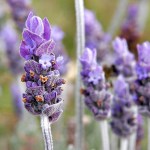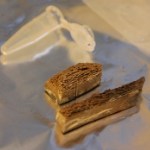horse
In looking back over the history of the blog, I thought it would be fun to take another glimpse at the top 5 most popular posts in 2017 thus far...
Image of lavender from GFDL 1.2, https://commons.wikimedia.org/w/index.php?curid=322384
While lavender aromatherapy has been documented to reduce stress in humans, little is known about its potential for reducing stress in veterinary medicine. Horses can develop elevated heart rates and stress hormone levels when they are confined to horse trailers and transported to new competition venues. Therapies to reduce stress in competition…
Image of lavender fromGFDL 1.2, https://commons.wikimedia.org/w/index.php?curid=322384
While lavender aromatherapy has been documented to reduce stress in humans, little is known about its potential for reducing stress in veterinary medicine. Horses can develop elevated heart rates and stress hormone levels when they are confined to horse trailers and transported to new competition venues. Therapies to reduce stress in competition horses are regulated and often prohibit the use of sedatives or oral supplements. Kylie Heitman, an undergraduate student at Albion College, was interested…
Skeletal muscle function and structure change as we age. Humans typically experience a loss of muscle mass or muscle weakness which can greatly reduce mobility and stability. While much is known about aging skeletal muscle in humans and rodents, less is known about horses, which are rather athletic animals that are living longer due to advancements in veterinary care and retirement programs. Researchers from the University of Florida decided to explore how aging effects skeletal muscles of horses. To do this, they examined gluteus medius (speed and locomotion)…
Tennessee Walking Horse photo by Just chaos. https://commons.wikimedia.org/w/index.php?curid=7128467
In a new study published in Physiological Genomics, researchers explored the role of genetics in the conformation of Tennessee Walking Horses. In other words, how close each animal they sampled looked to an "ideal" Tennessee Walking Horse. According to Kylee Jo Duberstein (Department of Animal and Dairy Science, University of Georgia), there are five criteria that are examined when evaluating the conformation of a horse. These include "balance, structural correctness,…
New research published in Biology Letters suggests that, similar to dogs, horses may understand our facial expressions. In a quote published in Discovery News, study author Amy Smith (University of Sussex) said, "It's possible that horses developed this ability during their 6,000-year co-evolution with humans, or indeed that individual horses learn it during their lifetimes."
To examine this question, the research team showed images of men with negative or positive facial expressions to 28 horses:
Sources:
AV Smith, L Proops, K Grounds, J Wathan, K McComb. Functionally relevant responses to…
I was very impressed by the graduate and undergraduate students who presented their research at the Scholander poster competition sponsored by the Comparative and Evolutionary Physiology section of the American Physiological Society this afternoon. I am sure the winner of the competition will be very difficult to select.
Some highlights included:
Bridget Martinez, graduate student at the University of California - Merced whose research focused on hormonal changes that occur with fasting in elephant seal pups. In mammals, food deprivation leads to lower…
Bone fragments used for sequencing the ancient horse genome. Image credit: LUDOVIC ORLANDO as published in The Scientist.
Researchers have successfully created a draft sequence of the complete genome of a 700,000 year old horse from a bone fragment extracted from permafrost in the Yukon Territory (Canada). This is the oldest specimen ever sequenced by almost 10-fold. Prior sequencing of the whole genome from a hominid from Siberia who lived 80,000 years ago was the prior record holder.
It is amazing to me that they were able to recover the entire genome from such an old specimen! These…
In general, the ability to attribute attention to others seems important: it allows an animal to notice the presence of other individuals (whether conspecifics, prey, or predators) as well as important locations or events by following the body orientation or eyegaze of others. We've spent a lot of time here at The Thoughtful Animal thinking about how domestication has allowed dogs to occupy a unique niche in the social lives of humans. They readily understand human communication cues such as eye-gaze and finger-pointing, and capitalize on the infant-caregiver attachment system to have their…
Breaking down a hyena kill. Given competition with other carnivores, prehistoric hyenas (like their living counterparts) would probably have disarticulated and transported parts of horses they killed. From Diedrich 2010.
In Hollywood films, there is nothing like an assemblage of bones strewn about a cave floor to testify to the power and voraciousness of a predator. Every skeleton is a testament to the hunting prowess of the carnivore, which causes even more alarm when the person who has stumbled into the cave realizes that they have just walked into a literal dead-end.
Although amplified…
Continuing our long tradition of espousing the virtues of dwarfism and breeding animals as tiny as possible regardless of the health consequences (i.e. adorability!), we bring you a contender for world's smallest horse. This thing should be painted pink or lavender immediately!
Riverdance Miniatures in Victoria, Australia may have set a new record for the world's smallest horse. This prematurely born foal stands only 15 inches high, or 3.3 "hands", in horse-speak. The previous record for a fully grown horse was 4 hands and 1 inch.
Miniature horses are in fact, miniature horses, and not ponies. They have a higher rate of dwarfism than normal horses, because, well, they were bred for it (see earlier post on a tiny horse going bonkers).
Add one of these horses, one of the formerly featured miniature pigs, and maybe a tiny sheep, and you'd have yourself the most…
Stupid BoingBoing always has the best stuff. Reminds me of my puppy when he escapes out of the door.
Once again, thanks to that Asian guy we know.
There are some animals that seem to exist in a bit of taxonomic confusion (at least in the literature; I don't think zebras lose sleep over their species names), the Plains Zebra being one of these. The animals pictured above are from the Philadelphia Zoo and listed as being members of the species Equus burchellii, but recent work appears to show that this most common of Zebra species should really be called Equus quagga. Burchell's Zebra, then, is relegated to the status of a subspecies with the name Equus quagga burchellii, itself taking precedence over the subspecies Equus quagga…
The accidental product of a study abroad program in Italy, Eclyse is a visually fascinating example of mixed genetic material. Eclyse's mother was a zebra living at a German safari park. When she was sent on loan to Italy, she was allowed to roam free in an enclosure with both horses and zebras. Upon her return to the amusingly named Schloss Holte Stukenbrock in Germany, keepers were surprised to find she was pregnant but even more surprised to see the young foal. Called a "zorse" or a "zebroid" (pretty much lose, lose if you ask us), typically the offspring of a zebra and horse have stripes…


